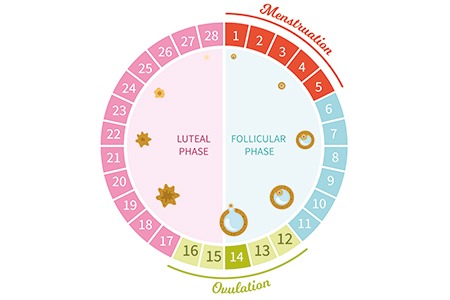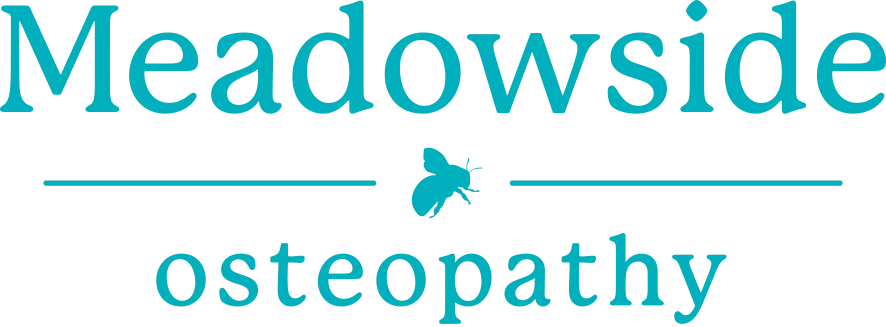Understanding your menstrual cycle can help you keep healthy and happy throughout the month.

The menstrual cycle is driven by the cyclical hormonal fluctuations which occur in our body throughout the month to prepare for potential pregnancy.
It’s made up of 2 main stages: follicular and luteal, with ovulation occurring halfway at day 14. Menstruation occurs in the first 5 days of the cycle. An average cycle is 28 days long, but this often varies – yours may be longer or shorter than this.
Whilst the menstrual cycle can feel like a hindrance to our daily lives, with a good understanding of what goes on at each stage we can align to our body’s natural cycle, and use it to our advantage when it comes to exercising and eating.
It’s becoming increasingly popular among female professional athletes to monitor their menstrual cycles and tailor their training around it. But how can you apply this to your daily life?
Track your cycle
Tracking your cycle is a good place to start, and will give you some useful insights, even if you are using contraception. It can help you listen to, and better understand your body’s natural rhythm.
You can track your cycle on most fitness devices, including Fitbit, Apple Watch and Garmin.
If you have a Garmin device, you can use the Garmin Connect app (in ‘more’ → ‘Health & Performance’ → ‘Menstrual Cycle’).
You can also use a dedicated health app, we’ve listed a few of them below.
Please note: There has been some bad press recently for some of these apps, raising privacy concerns for its users. Please do your research and make sure you’re happy with the T’s & C’s before signing up. All these apps below have released statements saying they don’t sell user personal data.
- Clue (highly recommended)
- Moody
- Flo
- Natural Cycles
Otherwise, if you prefer pen and paper, a designated notepad or diary is a great way to keep as little or as much information as you like.
Here’s a breakdown of the main phases of the cycle, and some tips for optimising exercise and nutrition during each stage:
Day 1-7: Menstruation
During this phase, also known as your period, you may be feeling more tired or experiencing painful abdominal cramps.
Cramps occur due to high levels of certain prostaglandins – hormone-like messengers which trigger contraction of blood vessels to aid in the shedding of the uterus lining.
Our recommendations:
- Exercise
During this phase, if you suffer from period pains and cramps, gentle movements such as restorative yoga, walks or low intensity workouts are recommended.
- Nutrition
Whilst the natural decline in the hormones oestrogen and progesterone may have you craving junk food, it is important to fuel up on good anti-inflammatory foods: nuts, fruit, leafy greens, lentils and other legumes are great.
If you’re craving chocolate, stick to dark chocolate for its inflammation fighting effects, or go completely natural with raw cacao nibs – a real superfood, easily available online, which can be added to cereal, fruit salad or yogurt.
Days 8-14: Late Follicular Phase and Ovulation
Days 8-14: Late Follicular Phase and Ovulation
Just before and during ovulation, higher levels of oestrogen and testosterone generate an increase in energy levels.
Evidence also shows greater muscle strength and diameter during this phase, so you would usually feel pretty invincible now!
Our recommendations:
- Exercise
This is the perfect time to get sweaty with high intensity workouts. Get to the gym for some cardio and strength training – you may notice you feel stronger and faster than usual.
Schedule important events and meetings here too – you’re most likely to be on your A-Game during this phase!
- Nutrition
Make sure you fuel up with enough protein to sustain your rising energy and activity levels. Lean meats, fish, beans, nuts and yogurt are all good options.
If you’re avoiding dairy, try coconut-based yogurts – delicious and nutritious!
Days 15-28: Luteal phase
The luteal phase is the final phase of the cycle. Oestrogen declines and progesterone rises, creating symptoms of PMS (premenstrual syndrome). You may feel more tired and irritable.
Our recommendations:
- Exercise
As body temperature rises, cardiovascular exercise may become more difficult, and you may notice that you tire more easily.
Instead of high intensity cardiovascular exercise, it is best to stick to more low intensity workouts such as Pilates, Tai Chi or walking. If you’re a runner, aim for lower speeds.
- Nutrition
Oestrogen promotes glucose availability, so its decline during this phase means that there is less glucose circulating in your blood. This may result in cravings for carbs and sugar.
Keep in mind that your body will be sensitive to sugar fluctuations, which make mood swings and other symptoms such as breast tenderness feel worse.
To avoid this, choose slow releasing complex carbs such as sweet potatoes, parsnips, oats, brown rice or wholemeal bread.
Always aim to add protein and fibre to your carbs, so they are broken down more slowly.
What if your cycle is different?
The above are the general trends and advice which apply to most – however, research is still in the early days and findings are mixed.
Menstrual cycles vary greatly from woman to woman and at different times in your life, so there is no ‘one-size fits all’. It’s important to listen to your body and follow how you feel.
If you have any concerns or questions about your cycle, your health or your fitness – talk to us. We are always here to listen and help, and will be able to point you in the right direction if further expertise is needed.
How we can help
Here at Meadowside, we always treat you as a whole person – no matter what has brought you to us.
We believe that getting your health and wellbeing to its optimum includes assessing and helping your whole body and lifestyle, not just the symptoms which prompted you to seek our help.
If you come to us for a consultation, we will take detailed medical history, and complete a comprehensive biomechanical assessment.
We can help with aches and pains that may be associated with your cycle, or training related injuries. We can also offer exercise rehabilitation, and advice and ideas to minimise symptoms and improve performance – including a tailor-made exercise programme, built for you by our clever software.
We also have links with trusted local Pilates, fitness and nutritional experts, which we can introduce you to.
What to do next?
If you would like to make an appointment, head to our booking page here.
You can book an initial 60-minute in-person consultation, or a free 15-minute telephone consultation with one of our Osteopaths – in which you can discuss your symptoms and decide the best way forward for you.
References:
Balachandar, V. (2017). Effects of the menstrual cycle on lower-limb biomechanics, neuromuscular control, and anterior cruciate ligament injury risk: a systematic review. Muscle, Ligaments And Tendons Journal, 7(1), 136.
https://doi.org/10.11138/mltj/2017.7.1.136
Oosthuyse, T., & Bosch, A. (2010). The Effect of the Menstrual Cycle on Exercise Metabolism. Sports Medicine, 40(3), 207-227.
https://doi.org/10.2165/11317090-000000000-00000
Sung, E., Han, A., Hinrichs, T., Vorgerd, M., Manchado, C., & Platen, P. (2014). Effects of follicular versus luteal phase-based strength training in young women. Springerplus, 3(1). https://doi.org/10.1186/2193-1801-3-668

